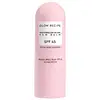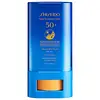What's inside
What's inside
 Key Ingredients
Key Ingredients

 Benefits
Benefits

 Concerns
Concerns

 Ingredients Side-by-side
Ingredients Side-by-side

Butyl Methoxydibenzoylmethane 3%
UV AbsorberHomosalate 5%
Skin ConditioningEthylhexyl Salicylate 5%
UV AbsorberNeopentyl Glycol Dicaprylate/Dicaprate
EmollientOctyldodecanol
EmollientC15-19 Alkane
SolventCoco-Caprylate/Caprate
EmollientSilica Silylate
EmollientButyloctyl Salicylate
Skin ConditioningPolyester-8
Skin ConditioningDibutyl Lauroyl Glutamide
Skin ConditioningSqualane
EmollientCapryloyl Glycerin/Sebacic Acid Copolymer
Skin ConditioningDibutyl Ethylhexanoyl Glutamide
Skin ConditioningVp/Eicosene Copolymer
Tocopheryl Acetate
AntioxidantCitrullus Lanatus Seed Oil
EmollientParfum
MaskingPentaerythrityl Tetra-Di-T-Butyl Hydroxyhydrocinnamate
AntioxidantTetrahexyldecyl Ascorbate
AntioxidantCaprylic/Capric Triglyceride
MaskingLimnanthes Alba Seed Oil
Skin ConditioningGlyceryl Behenate
EmollientSodium Hyaluronate
HumectantNiacinamide
SmoothingCrithmum Maritimum Extract
Skin ConditioningButyl Methoxydibenzoylmethane 3%, Homosalate 5%, Ethylhexyl Salicylate 5%, Neopentyl Glycol Dicaprylate/Dicaprate, Octyldodecanol, C15-19 Alkane, Coco-Caprylate/Caprate, Silica Silylate, Butyloctyl Salicylate, Polyester-8, Dibutyl Lauroyl Glutamide, Squalane, Capryloyl Glycerin/Sebacic Acid Copolymer, Dibutyl Ethylhexanoyl Glutamide, Vp/Eicosene Copolymer, Tocopheryl Acetate, Citrullus Lanatus Seed Oil, Parfum, Pentaerythrityl Tetra-Di-T-Butyl Hydroxyhydrocinnamate, Tetrahexyldecyl Ascorbate, Caprylic/Capric Triglyceride, Limnanthes Alba Seed Oil, Glyceryl Behenate, Sodium Hyaluronate, Niacinamide, Crithmum Maritimum Extract
Butyl Methoxydibenzoylmethane 2.5%
UV AbsorberHomosalate 10%
Skin ConditioningEthylhexyl Salicylate 5%
UV AbsorberOctocrylene 10%
UV AbsorberDiphenylsiloxy Phenyl Trimethicone
Skin ConditioningParaffinum Liquidum
EmollientHydroxystearic Acid
CleansingTriethylhexanoin
MaskingPEG/PPG-9/2 Dimethyl Ether
Skin ConditioningMethyl Methacrylate Crosspolymer
Dibutyl Lauroyl Glutamide
Skin ConditioningC12-15 Alkyl Benzoate
AntimicrobialPolyamide-8
EmollientSilica Dimethyl Silylate
EmollientTocopheryl Acetate
AntioxidantPEG/PPG-14/7 Dimethyl Ether
Skin ConditioningLecithin
EmollientGlycyrrhiza Glabra Root Extract
BleachingPPG-17
Skin ConditioningCastor Oil/Ipdi Copolymer
Caprylic/Capric Triglyceride
MaskingBHT
AntioxidantTocopherol
AntioxidantPEG-6
HumectantPentaerythrityl Tetra-Di-T-Butyl Hydroxyhydrocinnamate
AntioxidantSilica
AbrasiveParfum
MaskingButyl Methoxydibenzoylmethane 2.5%, Homosalate 10%, Ethylhexyl Salicylate 5%, Octocrylene 10%, Diphenylsiloxy Phenyl Trimethicone, Paraffinum Liquidum, Hydroxystearic Acid, Triethylhexanoin, PEG/PPG-9/2 Dimethyl Ether, Methyl Methacrylate Crosspolymer, Dibutyl Lauroyl Glutamide, C12-15 Alkyl Benzoate, Polyamide-8, Silica Dimethyl Silylate, Tocopheryl Acetate, PEG/PPG-14/7 Dimethyl Ether, Lecithin, Glycyrrhiza Glabra Root Extract, PPG-17, Castor Oil/Ipdi Copolymer, Caprylic/Capric Triglyceride, BHT, Tocopherol, PEG-6, Pentaerythrityl Tetra-Di-T-Butyl Hydroxyhydrocinnamate, Silica, Parfum
 Reviews
Reviews

Ingredients Explained
These ingredients are found in both products.
Ingredients higher up in an ingredient list are typically present in a larger amount.
Also known as Avobenzone, this ingredient is a chemical sunscreen filter that provides protection in the UV-A range.
Avobenzone is globally approved and is the most commonly used UV-A filter in the world.
Studies have found that avobenzone becomes ineffective when exposed to UV light (it is not photostable; meaning that it breaks down in sunlight). Because of this, formulations that include avobenzone will usually contain stabilizers such as octocrylene.
However, some modern formulations (looking at you, EU!) are able to stabilize avobenzone by coating the molecules.
Avobenzone does not protect against the UV-B range, so it's important to check that the sunscreen you're using contains other UV filters that do!
The highest concentration of avobenzone permitted is 3% in the US, and 5% in the EU.
Learn more about Butyl MethoxydibenzoylmethaneThis ingredient is an emollient, solvent, and texture enhancer. It is considered a skin-softener by helping the skin prevent moisture loss.
It helps thicken a product's formula and makes it easier to spread by dissolving clumping compounds.
Caprylic Triglyceride is made by combining glycerin with coconut oil, forming a clear liquid.
While there is an assumption Caprylic Triglyceride can clog pores due to it being derived from coconut oil, there is no research supporting this.
Learn more about Caprylic/Capric TriglycerideWe don't have a description for Dibutyl Lauroyl Glutamide yet.
Ethylhexyl Salicylate is an organic compound used to block UV rays. It primarily absorbs UVB rays but offers a small amount of UVA protection as well.
Commonly found in sunscreens, Ethylhexyl Salicylate is created from salicylic acid and 2-ethylhexanol. You might know salicylic acid as the effective acne fighter ingredient and BHA.
The ethylhexanol in this ingredient is a fatty alcohol and helps hydrate your skin, similar to oils. It is an emollient, which means it traps moisture into the skin.
According to manufacturers, Ethylhexyl Salicylate absorbs UV wavelength of 295-315 nm, with a peak absorption at 307-310 nm. UVA rays are linked to long term skin damage, such as hyperpigmentation. UVB rays emit more energy and are capable of damaging our DNA. UVB rays cause sunburn.
Learn more about Ethylhexyl SalicylateHomosalate is a chemical sunscreen filter that provides protection in the UV-B range (280nm - 320 nm), with a peak protection at 306 nm. It is internationally approved for use in sunscreens.
Homosalate is not photo-stable, meaning it's strength as a UV filter degrades over time with exposure to the sun. Because of this, it's often used in combination with other chemical sunscreen filters as avobenzone (which protects from the UV-A range). Homosalate also helps act as a solvent for harder-to-dissolve UV filters.
(Part of the reason that sunscreens need to be frequently re-applied is due to the photo instability of many chemical sunscreen filters)
Currently, homosalate is approved in concentrations up to 10% in the EU and 15% in the US. The FDA is currently doing further research on the effects of homosalate, and it is possible that these approved concentrations will change in the future.
Learn more about HomosalateParfum is a catch-all term for an ingredient or more that is used to give a scent to products.
Also called "fragrance", this ingredient can be a blend of hundreds of chemicals or plant oils. This means every product with "fragrance" or "parfum" in the ingredients list is a different mixture.
For instance, Habanolide is a proprietary trade name for a specific aroma chemical. When used as a fragrance ingredient in cosmetics, most aroma chemicals fall under the broad labeling category of “FRAGRANCE” or “PARFUM” according to EU and US regulations.
The term 'parfum' or 'fragrance' is not regulated in many countries. In many cases, it is up to the brand to define this term.
For instance, many brands choose to label themselves as "fragrance-free" because they are not using synthetic fragrances. However, their products may still contain ingredients such as essential oils that are considered a fragrance by INCI standards.
One example is Calendula flower extract. Calendula is an essential oil that still imparts a scent or 'fragrance'.
Depending on the blend, the ingredients in the mixture can cause allergies and sensitivities on the skin. Some ingredients that are known EU allergens include linalool and citronellol.
Parfum can also be used to mask or cover an unpleasant scent.
The bottom line is: not all fragrances/parfum/ingredients are created equally. If you are worried about fragrances, we recommend taking a closer look at an ingredient. And of course, we always recommend speaking with a professional.
Learn more about ParfumPentaerythrityl Tetra-Di-T-Butyl Hydroxyhydrocinnamate (long name, huh?) is a synthetic antioxidant.
It is used to help stabilize other antioxidants or prevent the color from changing in a product.
As an antioxidant, it helps fight free-radical molecules. Free-radical molecules are capable of damaging our cells and other genetic material. Thus, antioxidants may reduce the signs of aging.
This ingredient is oil-soluble.
Learn more about Pentaerythrityl Tetra-Di-T-Butyl HydroxyhydrocinnamateTocopheryl Acetate is AKA Vitamin E. It is an antioxidant and protects your skin from free radicals. Free radicals damage the skin by breaking down collagen.
One study found using Tocopheryl Acetate with Vitamin C decreased the number of sunburned cells.
Tocopheryl Acetate is commonly found in both skincare and dietary supplements.
Learn more about Tocopheryl Acetate